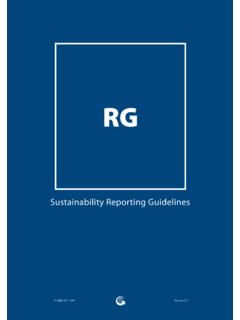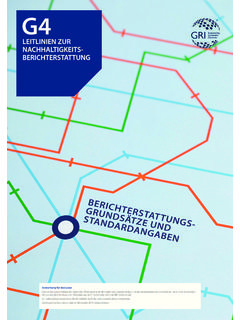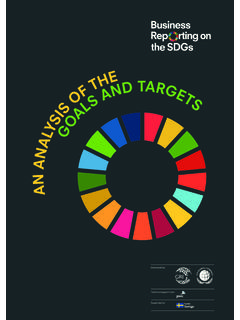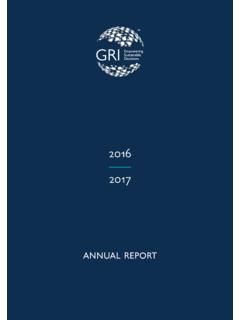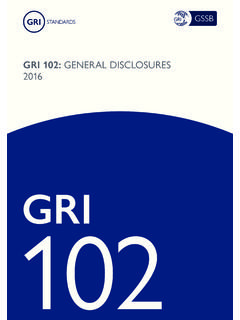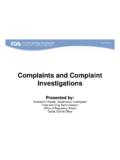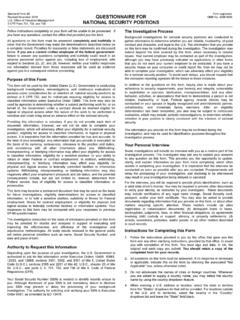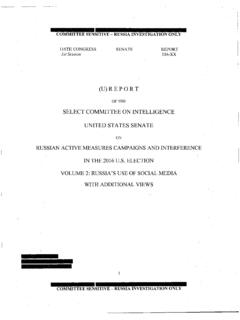Transcription of GRI 403: OCCUPATIONAL HEALTH AND SAFETY 2018
1 GRI 403: OCCUPATIONAL HEALTH AND SAFETY 2018 GRI4032 GRI 403: OCCUPATIONAL HEALTH and SAFETY 2018 Introduction 3 GRI 403: OCCUPATIONAL HEALTH and SAFETY 5 Scope of workers in this Standard 61. Management approach disclosures 8 Disclosure 403-1 OCCUPATIONAL HEALTH and SAFETY management system 9 Disclosure 403-2 Hazard identification, risk assessment, and incident investigation 10 Disclosure 403-3 OCCUPATIONAL HEALTH services 11 Disclosure 403-4 Worker participation, consultation, and communication on OCCUPATIONAL HEALTH and SAFETY 12 Disclosure 403-5 Worker training on OCCUPATIONAL HEALTH and SAFETY 13 Disclosure 403-6 Promotion of worker HEALTH 14 Disclosure 403-7 Prevention and mitigation of OCCUPATIONAL HEALTH and SAFETY impacts directly linked by business relationships 162.
2 Topic-specific disclosures 17 Disclosure 403-8 Workers covered by an OCCUPATIONAL HEALTH and SAFETY management system 17 Disclosure 403-9 Work-related injuries 19 Disclosure 403-10 Work-related ill HEALTH 23 Glossary 25 References 31 About this Standard ResponsibilityThis Standard is issued by the Global Sustainability Standards Board (GSSB). Any feedback on the GRI Standards can be submitted to for the consideration of the 403: OCCUPATIONAL HEALTH and SAFETY sets out reporting requirements on the topic of OCCUPATIONAL HEALTH and SAFETY . This Standard can be used by an organization of any size, type, sector or geographic location that wants to report on its impacts related to this referencesThis Standard is to be used together with the most recent versions of the following documents:GRI 101: Foundation GRI 103: Management Approach GRI Standards GlossaryIn the text of this Standard, terms defined in the Glossary are dateThis Standard is effective for reports or other materials published on or after 1 January 2021.
3 Earlier adoption is : This document includes hyperlinks to other Standards. In most browsers, using ctrl + click will open external links in a new browser window. After clicking on a link, use alt + left arrow to return to the previous 403: OCCUPATIONAL HEALTH and SAFETY 2018A. OverviewThis Standard is part of the set of GRI Sustainability Reporting Standards (GRI Standards). The Standards are designed to be used by organizations to report about their impacts on the economy, the environment, and society. The GRI Standards are structured as a set of interrelated, modular standards. The full set can be downloaded at There are three universal Standards that apply to every organization preparing a sustainability report: GRI 101: Foundation GRI 102: General Disclosures GRI 103: Management Approach GRI 101: Foundation is the starting point for using the GRI Standards.
4 It has essential information on how to use and reference the Standards. Figure 1 Overview of the set of GRI StandardsGRI 103 GRI 102 Topic-specificStandardsUniversal StandardsStarting point for using the GRI StandardsGRI 101 FoundationGeneral DisclosuresManagement ApproachTo report contextual information about an organizationTo report the management approach for each material topicSelect from these to report specific disclosures for each material topicGRI 300 EnvironmentalGRI 400 SocialGRI 200 EconomicAn organization then selects from the set of topic-specific GRI Standards for reporting on its material topics. See the Reporting Principles for defining report content in GRI 101: Foundation for more information on how to identify material topic-specific GRI Standards are organized into three series: 200 (Economic topics), 300 (Environmental topics), and 400 (Social topics).
5 Each topic Standard includes disclosures specific to that topic, and is designed to be used together with GRI 103: Management Approach, which is used to report the management approach for the topic. GRI 403: OCCUPATIONAL HEALTH and SAFETY is a topic-specific GRI Standard in the 400 series (Social topics).B. Using the GRI Standards and making claimsThere are two basic approaches for using the GRI Standards. For each way of using the Standards there is a corresponding claim, or statement of use, which an organization is required to include in any published The GRI Standards can be used as a set to prepare a sustainability report that is in accordance with the Standards. There are two options for preparing a report in accordance (Core or Comprehensive), depending on the extent of disclosures included in the report.
6 An organization preparing a report in accordance with the GRI Standards uses this Standard, GRI 403: OCCUPATIONAL HEALTH and SAFETY , if this is one of its material topics. 2. Selected GRI Standards, or parts of their content, can also be used to report specific information, without preparing a report in accordance with the Standards. Any published materials that use the GRI Standards in this way are to include a GRI-referenced claim. See Section 3 of GRI 101: Foundation for more information on how to use the GRI Standards, and the specific claims that organizations are required to include in any published 403: OCCUPATIONAL HEALTH and SAFETY 2018 Reasons for omission as set out in GRI 101: Foundation are applicable to this Standard.
7 See clause in GRI 101 for requirements on reasons for Requirements, recommendations and guidance The GRI Standards include:Requirements. These are mandatory instructions. In the text, requirements are presented in bold font and indicated with the word shall . Requirements are to be read in the context of recommendations and guidance; however, the organization is not required to comply with recommendations or guidance in order to claim that a report has been prepared in accordance with the These are cases where a particular course of action is encouraged, but not required. In the text, the word should indicates a These sections include background information, explanations, and examples to help organizations better understand the organization is required to comply with all applicable requirements in order to claim that its report has been prepared in accordance with the GRI Standards.
8 See GRI 101: Foundation for more information. D. Background context In the context of the GRI Standards, the social dimension of sustainability concerns an organization s impacts on the social systems within which it 403 addresses the topic of OCCUPATIONAL HEALTH and and safe work conditions are recognized as a human right and addressed in authoritative intergovernmental instruments, including those of the International Labour Organization (ILO), the Organisation for Economic Co-operation and Development (OECD), and the World HEALTH Organization (WHO): see and safe work conditions are also a target of the Sustainable Development Goals, adopted by the United Nations (UN) as part of the 2030 Agenda for Sustainable and safe work conditions involve both prevention of physical and mental harm, and promotion of workers of harm and promotion of HEALTH require an organization to demonstrate commitment to workers' HEALTH and SAFETY .
9 They also require the organization to engage workers in the development, implementation, and performance evaluation of an OCCUPATIONAL HEALTH and SAFETY policy, management system and programs that are appropriate to the organization s size and is essential that workers are consulted in the development of an organization s OCCUPATIONAL HEALTH and SAFETY policy, and participate in the processes necessary to plan, support, operate, and continually evaluate the effectiveness of the OCCUPATIONAL HEALTH and SAFETY management system and identification and risk assessment, worker training, and incident identification and investigation are also key to planning, supporting, operating, and evaluating the OCCUPATIONAL HEALTH and SAFETY management addition to preventing harm, an organization can promote workers HEALTH by offering healthcare services or voluntary HEALTH promotion services and programs, which, for example, help workers improve their diet or quit smoking.
10 These additional services and programs cannot serve as a substitute for OCCUPATIONAL HEALTH and SAFETY programs, services and systems that prevent harm and protect workers from work-related injuries and ill services and programs that aim to prevent harm and promote workers HEALTH are expected to respect workers right to privacy. Organizations are expected not to use workers' participation in such services and programs, or the HEALTH data derived therefrom, as criteria for their decisions regarding employment or engagement of workers, including termination, demotion, promotion or offering of prospects, compensation, or any other favorable or unfavorable See Target : Protect labour rights and promote safe and secure working environments for all workers, including migrant workers, in particular women migrants, and those in precarious employment , within Goal 8: Promote sustained, inclusive and sustainable economic growth, full and productive employment and decent work for all.
